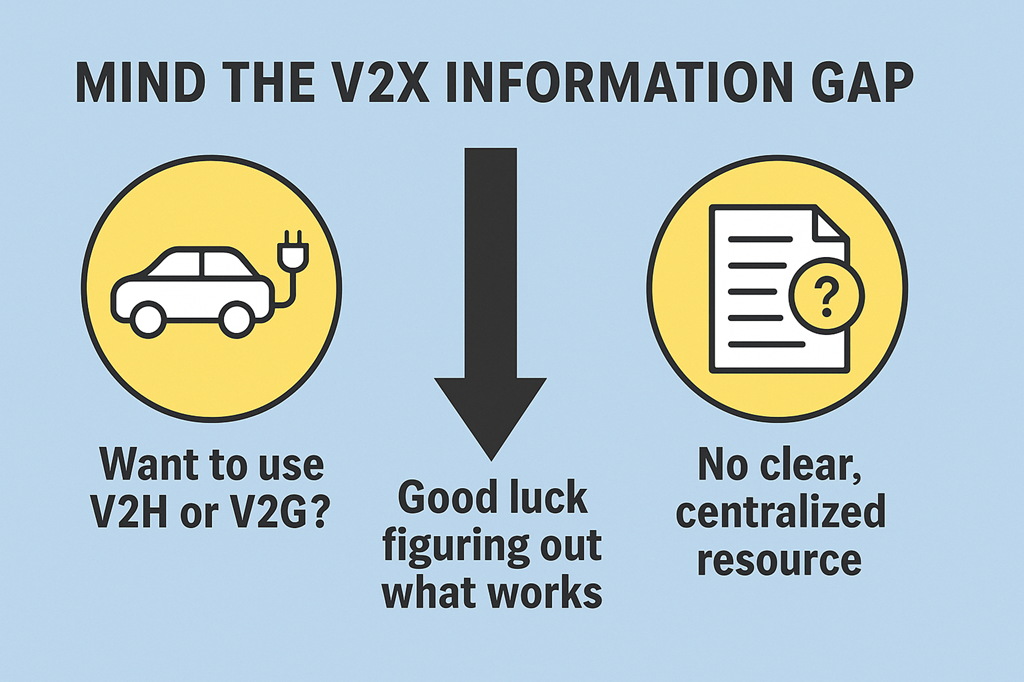
Consumers interested in Vehicle-to-Home (V2H) or Vehicle-to-Grid (V2G) technologies face a frustrating challenge: there’s no clear, centralized resource that explains which EVs and bidirectional chargers are compatible and for what use case.
For residential V2H, consumers are currently limited to proprietary, vehicle-specific solutions. A prime example is the Ford F-150 Lightning, which requires pairing the Charge Station Pro with Sunrun’s Home Integration System to enable home backup. Other OEMs are beginning to offer similar packages—for instance, GM’s Energy V2H Enablement Kit is now rolling out. But there’s no standardization, no compatibility matrix, and little transparency for homeowners trying to evaluate options.
On the commercial V2G side, system integrators face a different but equally frustrating problem: uncertainty about which medium- and heavy-duty (MHD) EVs are compatible with which bidirectional chargers. Without clear documentation or standardized testing, every deployment becomes a bespoke integration effort—raising costs, increasing risk, and slowing scale.
This information vacuum is more than an inconvenience—it’s a critical barrier to adoption. Without reliable, public-facing guidance, early adopters hesitate, installers can’t make confident recommendations, and utilities lack the certainty needed to design scalable programs. And all this at a time when V2X is technically viable and urgently needed to enhance grid flexibility, resilience, and decarbonization.
🔍 The California V2G Equipment List: A Start, But Not Enough
The California V2G Equipment List (V2GEL), developed by the California Energy Commission, is one of the few publicly available resources attempting to catalog V2G-capable charging equipment.[i] But it’s not nearly enough to meet the needs of today’s rapidly evolving market.
The list is outdated and includes products with uncertain market availability. For example, I previously worked at Fermata Energy, which is no longer operating as an independent entity following its acquisition by Nuvve.[ii] The Fermata Energy bidirectional charger—built on the CHAdeMO standard—faces limited market potential, with no announced plans (to my knowledge) for a CCS version. Similarly, BorgWarner, which had entered the high-power bidirectional charging space for school buses and medium- and heavy-duty (MHD) fleets through its acquisition of Rhombus Energy Solutions, has recently announced its exit from the EV charging market.[iii]
The V2GEL also lacks critical information on EV compatibility. Identifying whether a charger is bidirectional is only part of the equation. Consumers, contractors, and integrators also need to know which EV models support power export—and under what conditions (e.g., hardware, firmware, or interconnection requirements).
Another notable limitation is that only one residential V2G unit is listed: dcbel’s Home Energy Station.[iv] This singular listing gives a misleading impression of the options available to homeowners interested in using their EV for backup power, solar self-consumption, or time-of-use optimization.
📌 Why This Information Gap Matters
A robust, up-to-date compatibility resource is not just a nice-to-have. It’s essential infrastructure for the V2X ecosystem. Think about the role that approved product lists play in distributed energy resource (DER) programs: they streamline procurement, simplify interconnection, and reduce uncertainty for all market participants. We need the same for V2X.
Without a trusted resource, we risk undermining the momentum this sector is finally starting to build. And we know what happens when consumers are confused: they wait.
📏 Standards Matter—And They’re Still a Work in Progress
Part of the problem is rooted in the lack of standardized approaches to V2X communication and certification. There’s no universal framework for how automakers, charger manufacturers, and software platforms declare—or verify—bidirectional capabilities.[v]
- Some products support ISO 15118-20, others rely on proprietary communication protocols
- Few manufacturers clearly indicate whether their products support V2H, V2G, or both
- Certification for interoperability is still in its early stages
This lack of uniformity creates confusion for consumers, risk for installers, and real obstacles for utilities trying to build programs around this emerging resource.
🏗️ Who Should Step In?
Solving this will require collaboration across the V2X value chain. Automakers, EVSE manufacturers, software providers, standards bodies, and utilities all have important roles to play.
But to create a durable, public-facing solution, we especially need leadership from industry associations, national laboratories, and state energy offices. A V2X Compatibility Guide—regularly updated and widely trusted—would give consumers, contractors, and program designers a foundation they can build on.
⚡ Final Thought
2X is not a futuristic concept—it’s here. But the missing piece is knowledge infrastructure: the connective tissue that enables technology, markets, and policy to align. This alignment is essential to support scaled deployment and to fulfill the promise of EVs as a massive source of grid flexibility—something power systems around the world are increasingly desperate for.
We know how to do this. Let’s not allow the absence of a shared, trusted resource to stall a critical piece of the clean energy transition.
Let’s build the knowledge infrastructure this transition demands.
#V2X #V2G #EVcharging #VehicleGridIntegration #CleanEnergy #EnergyTransition #DER
[i] See California Energy Commission, Vehicle-to-Grid Equipment List (V2GEL) available at https://v2gel.energy.ca.gov/.
[ii] See Nuvve, Nuvve Expands IP, Revenue, and Market Reach with Strategic Assets Acquisition of Fermata Energy available at https://investors.nuvve.com/news-releases/news-release-details/nuvve-expands-ip-revenue-and-market-reach-strategic-assets.
[iii] See BorgWarner, BorgWarner Acquires Rhombus Energy Solutions available at https://www.borgwarner.com/newsroom/press-releases/2022/08/03/borgwarner-acquires-rhombus-energy-solutions.
[iv] See dcbel, Ara home energy station specifications available at https://www.dcbel.energy/ara/?gad_source=1&gad_campaignid=22143995471&gbraid=0AAAAABaMam3pOvxJF6ZK4o_YbZ51Xzw7m.
[v] See QualityLogic, Confused About Standardizing V2G? You’re Not Alone! available at https://www.qualitylogic.com/knowledge-center/confused-about-standardizing-v2g-youre-not-alone/.